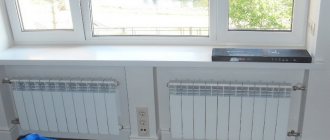Modern interior designers are trying to maximize the space in any room. To create a work space or a place to relax, a battery on the balcony will be useful. There you can make a living room, a terrace and even a greenhouse. But such repairs will require perseverance, work and courage: after all, realizing such a dream is not at all easy. Removing the battery to the balcony is an important stage of repair. This is a difficult and lengthy task, and many obstacles will arise on the way to the implementation of this project.
View from the insulated balcony Source dekormyhome.ru/
Main obstacles
Many doubt their choice and want to find out whether it is possible to place the battery on the balcony without legal consequences. This cannot be done, even if absolutely necessary. Unauthorized movement is illegal and is subject to fines. There are very good and significant reasons for this, knowing which, you want to refuse such a risky repair.
Causes:
- Risk of flooding neighbors below. The heating radiator may freeze and burst, then boiling water will flood everyone who lives below. Even a pre-insulated balcony will not save you from this.
- Extra load on the central heating system. This is an extremely complex system that requires careful handling and strict adherence to operating conditions. If you add another balcony radiator to the already working radiators, the pressure of hot water in them will weaken. Then they won't be able to heat as well as before, so the whole house will become cold.
- Difficulties during the sale of an apartment. It is imperative to show the buyer documents indicating all the parameters, including the layout of the housing and the thermal circuit. After a major renovation, the heating circuit changes, then the apartment owner will have to make repairs again and remove the excess radiator. Therefore, you need to obtain permission for redevelopment in advance or not start it at all.
- The increased cost (due to the fact that heating will have to be stronger due to the cooling of the system) will be paid by all residents of the house, and not just the initiator of the repair. You need to understand how utility bills are calculated: the total total area is divided by the number of residents of the house. Moving the battery will lead to prices rising, and not only the initiator of the redevelopment will have to pay, but also all other people.
For these reasons, placing the battery on the balcony is prohibited by law. You need to take care of yourself and those around you and insulate the loggia using alternative methods - using high-quality heaters and floor insulation.
Illegal transfer of batteries to the balcony is prohibited Source okna-dom.net
Difficulties
Knowing the laws, the owner of the apartment will understand why it is impossible to transfer batteries to the loggia. These places are not intended for living, so they are not heated. You can't do any redevelopment there, you can't radically change anything. But subject to a number of conditions and strict restrictions, it is still possible to move it. Achieving this goal and making accurate calculations will require a lot of time, money and effort. Therefore, it is best to insulate the floor and install a heater. This is much simpler, cheaper and safer; such repairs do not need to be coordinated with anyone.
Before remodeling, you need to close all the cracks. If all insulation work is not carried out efficiently, the heating effect will be minimal.
Layout of batteries on the loggia Source mastergrad.com
What to do?
Comfortable renovations and original interior design can be done with the simplest things. Instead of a battery, it is much easier to place a heater on the balcony by choosing a convenient model. There are now various types of home heaters on the market. Old equipment spent a lot of electricity, but now infrared heaters have appeared:
- ceiling;
- wall;
- floor
They spend little energy, but warm the room perfectly and can automatically turn off when warm.
Two batteries on a closed loggia Source www.isstone.net
Moving the battery to the balcony without violating the law
Installing a heating element on a balcony can be done quite legally, but in this case you need to be prepared for certain difficulties and inconveniences. The first thing that will be required of you is the exact parameters:
- temperature;
- how many sections need to be installed;
- section dimensions;
- future localization of heating sections;
- pressure in pipes.
An amateur will not be able to correctly carry out accurate calculations, so you need to turn to professional designers. Their services are quite expensive, so you will have to spend a significant amount.
Then they must write an application with a corresponding request to transfer the heating element to the housing and communal services inspection. They will require:
- results of accurate calculations;
- from experts - official confirmation that the risk of water freezing in the radiator is minimized;
- signed redevelopment project (from professionals);
- calculation of thermal conductivity.
The housing inspection has the right to require additional documents, for example, an apartment registration certificate. The list of documents may vary depending on the specific legislation of the region.
Two radiators on the loggia Source sofos-okna.ru
The housing inspectorate gives permission within several months. There is a high chance of getting rejected. Therefore, you should never get down to business until this permission has been received. This is a violation of the law, for which you can be fined.
While the documents are being approved, you can insulate the balcony. Without this, moving the radiator is pointless and dangerous. In addition, the lack of insulation will not allow you to prove that the permissible temperature is maintained on the loggia.
To achieve his goal, the apartment owner must perform several actions.
- Make accurate calculations.
- Report to the housing inspectorate.
- Carry out total and high-quality insulation of the room.
You cannot carry out work first and then seek permission. You cannot do illegal redevelopment: sooner or later the neighbors and the housing inspector will find out about it, and then you will have to pay a fine.
Radiator on the balcony Source royal-comfort.ru
Sequencing
So, the legal and technically correct sequence of actions if you want to place a heating radiator on the balcony consists of the following steps:
- insulation of external walls;
- coordination of redevelopment, obtaining relevant permits and conclusions;
- choosing the optimal type of radiator and installation method;
- wall preparation - installation of thermal insulation, finishing;
- direct installation.
If you are firm in your intentions, then for apartment buildings it is recommended to move the radiator from the room to the balcony, and not to install an additional one, which will immediately significantly reduce the efficiency of the general building system - this is unlikely to please the neighbors and will entail inspections.
Laws
Before interfering with construction and communication systems, you should carefully read the Housing Code of the Russian Federation:
- Art. 15, paragraph 5 - here are the conditions that make it possible to recognize that the premises are intended for living. Based on this article, you need to prove to the housing inspectorate that the loggia will also become a living room after renovation.
- Art. 25, paragraph 1 - heating and other utilities can be transferred, but only in living rooms, to which the loggia does not belong.
These parts of the law will allow legal redevelopment to be granted, subject to a number of strict conditions being met.
Punishment
Illegally removing the battery onto the loggia puts all residents of the house at risk and creates a number of difficulties for them. There is a penalty for unauthorized redevelopment. In 2022, individuals will pay a fine of 2,500 rubles, and legal entities - 70 thousand rubles.
In addition to paying a fine, the violator will have to remove the radiator from the balcony at his own expense and restore everything to its original condition. This decision can be challenged, but you will have to prove that the repairs will not harm anyone. You will need a conclusion from specialists and the signatures of all residents of the house.
Balcony after renovation Source proffstroygroup.ru
Package of documents required for approval
First of all, you need to prepare a project specifying the types of equipment and installation locations.
The technical report must indicate the location of heating devices.
Important to note:
- for a thermal engineering calculation proving that heat losses will not increase as a result of the redevelopment;
- to maintain access to heating risers.
A written appeal is submitted in the prescribed form through the MFC or during a personal visit, attaching:
- the original or a notarized copy of the document confirming ownership of the apartment - purchase and sale agreement, exchange, donation, will;
- compliant refurbishment project;
- registration certificate for the apartment;
- written consent to the relocation of all adult family members living with the applicant at the specified address.
After completing the installation of the battery at a new location, a commission is invited to sign an acceptance certificate, which serves as the basis for making changes to the technical passport.
Types of batteries
After approval, you need to purchase suitable batteries. Their choice must be approached responsibly. To do this, you need to have a good understanding of their varieties and features.
There are three classes of radiators, which differ from each other in materials and their quality:
- Economy - cast iron, steel.
- Middle - bimetal, aluminum, tubular steel.
- Premium - made from the same materials, but improved, cast, designer.
Materials vary in quality and service life. You need to immediately choose the appropriate option.
Types of radiator for a loggia:
- Cast iron takes a long time to heat up and cools down slowly. They serve for 35 years, longer than all other types.
- Aluminum - have high thermal conductivity, heat up quickly, and weigh little. They serve for 15–20 years. But they can deteriorate due to the fact that the liquid inside the pipes has an inappropriate pH. Aluminum radiators are only suitable for an autonomous heating system, for example, in a private house.
- Steel panels are of high quality, have excellent heat dissipation, and are inexpensive. Service life - 15 years.
- Tubular steel - high quality and durable. In stores you can find a variety of design solutions for any interior. Expensive. They serve properly for about 15 years.
- Bimetallic - have a pipe frame on which an aluminum “jacket” is located. This is a prefabricated structure that may leak. You need to choose a model in which only steel parts are in contact with water, and aluminum serves as the outer covering. There is a way to check the quality of a bimetallic battery: you need to run a magnet over it. If the magnet sticks to the horizontal and vertical parts, then the battery is of high quality. If it does not stick to these parts, then there is no steel inside it. Bimetallic radiators are resistant to water hammer, mechanical damage and coolant water. This is the best option for any apartments and houses. They serve for 25–30 years.
Knowing the features of all types of radiators, you can make the right choice and install the appropriate model.
Bottom, side, diagonal arrangement and connection of pipes Source learnmech.com
Choosing a radiator
When the procedure for obtaining permission has been successfully completed, it is time to choose a room heating element that is suitable for the loggia.
All batteries are divided into 3 types:
- economy segment;
- middle class;
- premium
The main criteria for differences are cost, quality of materials and duration of operation.
Cast iron
The best and most durable metal of all times has been and remains cast iron. The shelf life of such radiators is more than 35 years. They are stronger than analogs made from other materials, but they weigh a lot. It is recommended to install it on the loggia only from the side of the house wall. The balcony can support no more than 600 kg of weight.
There is no need to additionally load it, because there is an installed double-glazed window, finishing, tiles on the floor (or other covering), and furniture. They look quite massive and the classic look does not always fit into a modern interior.
Aluminum
They weigh much less, are made in a modern design, and conduct heat well. The only negative: they can rust and deteriorate if the water they receive is of poor quality. Recommended for private homes where the source of water is known and autonomous.
Bimetal
Radiators of this type are most often used in apartment buildings. Bimetallic structures are compact and look laconic. They come in different sizes, conduct and release heat well. Ideal for a balcony or loggia due to its light weight and versatility in installation.
How to calculate the number of sections
There are standards that will allow you to make accurate calculations and indicate how many sections are needed to maintain warm weather indoors. The following conditions must be met:
- for 1.5 m2 - 1 part made of bimetal;
- for 2 m2 - 1 part made of aluminum;
- spare 1-2 parts.
All batteries are assembled from parts, so you need to know exactly the number of sections.
Scheme for moving a radiator to a balcony Source mastergrad.com
Let's sum it up
To transfer radiators to the loggia, you must obtain permission from the relevant authorities. This may take quite a long time. Therefore, in most cases it makes sense to consider other options: warm floors, ceiling infrared heating. Such systems are no less effective, and installation does not require approvals.
Sources
- https://tgorlovka.com/2020/07/30/mozhno-li-samostoyatelno-i-bez-soglasovaniya-perenosit-batarei-v-kvartire/
- https://fanera-info.ru/sovety-dlya-doma/nuzhno-li-razreshenie-na-perenos-batarey
- https://VseOBalkonah.ru/lodzhiya/perenos-batarei-na-lodzhiyu.html
- https://okna-dom.net/pernos-batarei-na-lodjiyu/
- https://GSPS.ru/nuzhno-li-soglasovyvat-perenos-batarei.php
- https://apb1.ru/nuzhno-li-soglasovyvat-perenos-batarei.html
- https://zonabalkona.ru/remont-otdelka/batarei-na-balkone.html
- https://TeploRes.ru/montazh-i-remont/kak-vyvesti-batareyu-na-lodzhiyu.html
How do you like the article?
Sergey Vladimirovich
Ask a Question
Connection options
It is very important to choose the right option for the location of the radiator pipes on the balcony. There are several types:
- Bottom - both heating pipes are located at the bottom of the battery. The inlet pipe is placed on one side, and the outlet pipe on the opposite side. In order for the radiator to heat up well and give off heat, you need to leave a sufficient distance between the fittings.
- Lateral - on one side of the battery there are inlet and outlet pipes. It is important that there is a large distance between the fittings so that the radiator heats up effectively.
- Diagonal - the inlet pipe is located on top of one half of the radiator, and the outlet pipe is located below on the other half. The best option because it provides the least heat loss.
It is necessary to remember the conditions of the loggia and choose the appropriate connection option:
- There is a tap and a jumper - the coolant evenly heats the pipes without heat loss. The best option.
- Only with a jumper - if it gets too hot, you can easily block the flow of boiling water into the pipes.
- Only with a tap - allows you to shut off the flow of coolant and temporarily remove the battery for repairs.
These options will allow you to regulate the degree of heating of the battery on the balcony.
Installation Rules
All work on moving the battery to the loggia should be carried out only by highly qualified professionals, masters of their craft. This is an extremely difficult job: one wrong move and the whole house will suffer. All connecting nodes must be perfectly sealed. The owner of the apartment will have to order services from specialists. But no professional craftsman will perform such work if the owner does not have official permission to remove the battery to the balcony.
It is advisable to carry out this work in the summer, when there is no heating. Moving a heating radiator to a balcony is extremely undesirable and dangerous during the heating season. You will have to turn off the heating in the entire house. Such a permit costs money and the neighbors will not like it. In addition, you will need to shut off the riser at the appointed time, and this will deprive all neighbors of heat.
Radiator on the balcony near the wall Source sofos-okna.ru
We heat your balcony using a central heating system
Russian people are accustomed to considering a balcony as something similar to a rubbish dump, not perceiving it as additional footage. This is a fundamentally wrong approach, because if you install central heating, the balcony will miraculously turn into an additional cozy room. A chic solution for small apartments, always suffering from small square footage and a large number of residents.
But how to heat a loggia?
What minimum knowledge will a person need when transferring heat to the most interesting part of his apartment?
Requirements
There are a number of strict requirements that must be met in order to achieve excellent heat transfer:
- you need to retreat at least 2–3 cm from the wall;
- place the supply pipes at a slope of 5–10 mm per linear meter;
- 10–12 cm from the window sill;
- 12–14 cm from the floor;
- the battery is placed evenly in all directions (use a level);
- the window sill covers the battery;
- to regulate the temperature on the loggia and the supply of coolant water, you need to make a jumper with a ball valve;
- You cannot bend the pipes too much or too often: these bends cause air pockets that block the supply of boiling water and have a bad effect on the operation of the entire heating system as a whole.
To comply with all these requirements, it is necessary to check each action using a tape measure, ruler and level. It is advisable to attach a screen wrapped in foil to the wall to better retain heat. The foil will glow and direct warmed air into the room.
Heated balcony floor Source kapiteltk.ru
How to install a battery on the balcony
After receiving the documents and concluding an agreement with the craftsmen, you can begin work. To move the battery to the loggia/balcony you will need a lot of professional equipment.
What you will need for work:
- battery;
- reinforced polypropylene pipes;
- level;
- brackets;
- Bulgarian;
- drill;
- all the necessary details;
- Mayevsky crane,
- roulette;
- soldering iron or welding device.
Ceiling, wall, floor infrared heaters Source nikotools.kz
How to install the battery on the balcony:
- Remove the old radiator.
- The pipes in the room from which the radiator is being removed must be cut - 10 cm from the place where the battery is connected.
- Use a drill to drill holes in the wall with a diameter of 2 cm. Pipes connecting the riser and the battery will pass through them.
- Cut threads on pipes.
- Pull the pipes through the holes so that they extend 8–10 cm into the room.
- Mount all the elements: first the roll, then the connections, fittings, and then the riser. All parts must fit in size and have threads.
Balcony with a single battery Source urs-ufa.ru
- Connect the pipes using a waterproofing agent (fum tape or tow).
- Place the radiator against the wall and use a level to mark the places where the fasteners will be installed.
- Attach the battery to three brackets. The first is located at the top, the remaining two are at the bottom. It is better to secure a massive battery on 4 brackets.
- Connect the Mayevsky tap, adjust other taps and plugs.
- Check the tightness of the entire structure.
- Connect the pipes.
It is advisable to entrust these works to professional craftsmen with experience and qualifications. It is dangerous to do such complex repairs with your own hands: any mistake can be fatal.
Warm floor
A thrifty owner takes care of all heating, regardless of costs. Typically, heated floors are made using an electric heating tool, but you should not spend extra money if you have centralized heating. It’s really possible to make a warm floor with your own hands, and then enjoy it on long winter evenings, covered with a blanket, looking out the window. For a warm floor, you will need insulating material: cotton wool, padding polyester, foam rubber, ordinary unnecessary rags. A large number of wooden beams and cleanly planed boards. The strength of the floor and the coating as a whole depends on the wood chosen. Next is a matter of technology. Connect a separate pipe, install a distributor and run two parallel pipes in a zigzag pattern across the floor. Install wooden beams between the pipes, easing the severity and preventing the possibility of flooding. We lay insulation material between the beams, carefully fix it, or cover it with a moisture-resistant solution. Boards are laid on top of the beams and can be connected to each other. If desired, lay parquet, linoleum, carpet.











